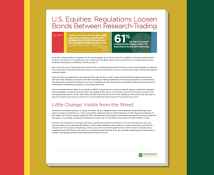From the outside, degree of change can be hard to gauge: Do a few trucks in the neighbor’s driveway indicate that a modest renovation or a complete gut job is underway? Similarly, while on the surface the U.S. equity business looks relatively unchanged, something is clearly going on.
Since 2013, the size of the business as measured by commissions generated has shown only minor fluctuations. Likewise, the commissions institutions allocate to pay for research and advisory services as well as the length of broker lists appear relatively stable.
However, there are signs that a fundamental shift may be afoot, most notably in the traditional alignment between sell-side firms’ standing in research with their standing in trading. Institutions’ evolving approaches to compensating the sell side for research and advisory services, including how they think about commission-rate structures and use of commission management programs, is loosening these ties.
These developments are likely to accelerate as MiFID II requirements in Europe lead the largest investment managers toward globally consistent practices.
Buy-side trading desks will be increasingly removed from broker research-vote and payment processes. At the same time, sell-side firms will focus even more intently on how much they are paid for specific products and services and be less concerned about which payment mechanisms are used.
MethodologyGreenwich Associates conducted in-person and telephone interviews regarding U.S. equity investing with 223 U.S. equity portfolio managers and 320 U.S. equity traders between November 2015 and February 2016. Respondents answered a series of qualitative and quantitative questions about the brokers they use and their businesses in the U.S. cash equity space.

